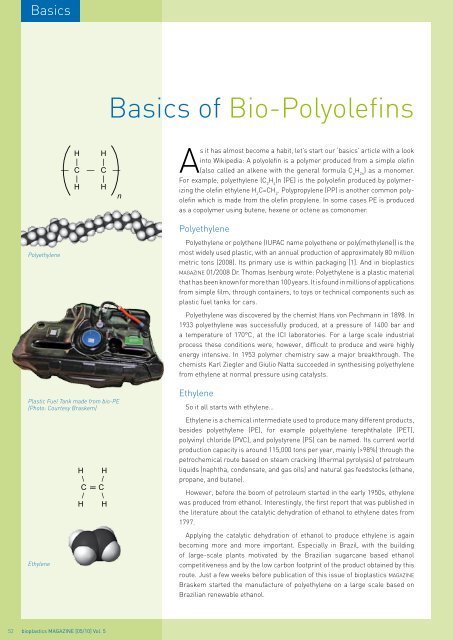05 | 2010
You also want an ePaper? Increase the reach of your titles
YUMPU automatically turns print PDFs into web optimized ePapers that Google loves.
Basics<br />
Basics of Bio-Polyolefins<br />
Polyethylene<br />
H H<br />
| |<br />
— C — C —<br />
| |<br />
H H<br />
n<br />
Plastic Fuel Tank made from bio-PE<br />
(Photo: Courtesy Braskem)<br />
Ethylene<br />
H H<br />
\ /<br />
C ═ C<br />
/ \<br />
H H<br />
As it has almost become a habit, let’s start our ‘basics’ article with a look<br />
into Wikipedia: A polyolefin is a polymer produced from a simple olefin<br />
(also called an alkene with the general formula C n<br />
H 2n<br />
) as a monomer.<br />
For example, polyethylene (C 2<br />
H 4<br />
)n (PE) is the polyolefin produced by polymerizing<br />
the olefin ethylene H 2<br />
C=CH 2<br />
. Polypropylene (PP) is another common polyolefin<br />
which is made from the olefin propylene. In some cases PE is produced<br />
as a copolymer using butene, hexene or octene as comonomer.<br />
Polyethylene<br />
Polyethylene or polythene (IUPAC name polyethene or poly(methylene)) is the<br />
most widely used plastic, with an annual production of approximately 80 million<br />
metric tons (2008). Its primary use is within packaging [1]. And in bioplastics<br />
MAGAZINE 01/2008 Dr. Thomas Isenburg wrote: Polyethylene is a plastic material<br />
that has been known for more than 100 years. It is found in millions of applications<br />
from simple film, through containers, to toys or technical components such as<br />
plastic fuel tanks for cars.<br />
Polyethylene was discovered by the chemist Hans von Pechmann in 1898. In<br />
1933 polyethylene was successfully produced, at a pressure of 1400 bar and<br />
a temperature of 170°C, at the ICI laboratories. For a large scale industrial<br />
process these conditions were, however, difficult to produce and were highly<br />
energy intensive. In 1953 polymer chemistry saw a major breakthrough. The<br />
chemists Karl Ziegler and Giulio Natta succeeded in synthesising polyethylene<br />
from ethylene at normal pressure using catalysts.<br />
Ethylene<br />
So it all starts with ethylene…<br />
Ethylene is a chemical intermediate used to produce many different products,<br />
besides polyethylene (PE), for example polyethylene terephthalate (PET),<br />
polyvinyl chloride (PVC), and polystyrene (PS) can be named. Its current world<br />
production capacity is around 115,000 tons per year, mainly (>98%) through the<br />
petrochemical route based on steam cracking (thermal pyrolysis) of petroleum<br />
liquids (naphtha, condensate, and gas oils) and natural gas feedstocks (ethane,<br />
propane, and butane).<br />
However, before the boom of petroleum started in the early 1950s, ethylene<br />
was produced from ethanol. Interestingly, the first report that was published in<br />
the literature about the catalytic dehydration of ethanol to ethylene dates from<br />
1797.<br />
Applying the catalytic dehydration of ethanol to produce ethylene is again<br />
becoming more and more important. Especially in Brazil, with the building<br />
of large-scale plants motivated by the Brazilian sugarcane based ethanol<br />
competitiveness and by the low carbon footprint of the product obtained by this<br />
route. Just a few weeks before publication of this issue of bioplastics MAGAZINE<br />
Braskem started the manufacture of polyethylene on a large scale based on<br />
Brazilian renewable ethanol.<br />
52 bioplastics MAGAZINE [<strong>05</strong>/10] Vol. 5


















